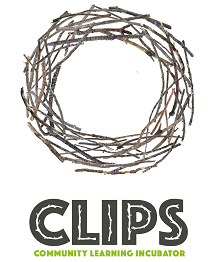The CLIPS model
In designing CLIPS we developed a conceptual model of concentric circles to show complex dynamics and layers found in community projects. Layers start with the relation between the Individual and the Community, and continue with Intention, Structure and Practice.
The CLIPS model visualises the interconnectedness between the layers, starting from the dual core of the Individual and the Community. These two are in the centre as they are crucial for healthy development of any project. There is no thriving community without thriving individuals; functional community is very conducive to individual growth.
The next step in developing a community-led project is setting Intentions.
Then comes creation of functioning Structures. Structures must be aligned with intentions and values. Governance, decision-making, property and power, communication, etc. must be put in place. The layer of actual Practice takes shape last, stemming from Intentions and Structures.
Ideally Individual, Community, Intention, Structure and Practice are perfectly interlinked. However, in our experience Practice is not always linked well to Intentions. Structures can be missing or inadequate, creating confusion and disruptions. Intentions can suffer from not being revisited and kept alive, perhaps because they are only fully owned by a few of the original founders. Coherence between Intention, Structure and Practice, and the balance between the Individual and the Community, are under constant challenge. Reasons for conflicts and malfunctions can generally be traced to not paying enough attention to interconnection between the layers or to neglecting one of the layers.
The CLIPS guide focuses on the first four layers: Individual, Community, Intention, and Structure. The fifth layer, Practice, is covered with a few examples that seek to illustrate the connections between the layers.








